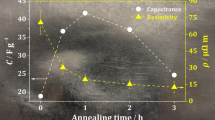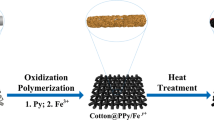Abstract
It is very important to develop electrode materials with good mechanical flexibility and excellent electrochemical performance to adapt to the development of flexible electronic devices, and the preparation of non-binder flexible electrode is a good strategy. In this work, nitrogen-doped carbon nanotubes (N-CNT) were grown in situ on the surface of carbon cloth (CC) by a simple method and directly used as binder-free electrodes for supercapacitors. The electrochemical tests show that the electrode can achieve an areal capacitance of 4081.6 mF/cm2 when the ampere density is set at 2mA/cm2, and when the ampere density is promoted 10 times to 20mA/cm2, this electrode can still retain 72.8% of the areal capacitance at 2mA/cm2. The flexible electrode can also retain 90.3% of an areal capacitance after 5000 recharge/discharge cycles at a set ampere density of 10 mA/cm2 and 97.6% of its areal capacitance after 50 bending cycles. The electrode was assembled into a symmetrical supercapacitor for electrochemical performance testing, and an areal capacitance of 572.6 mF/cm2 can be maintained when the ampere density is set at 2 mA/cm2, and an energy density of 79.53 and 40.28 µWh/cm2 at a power density of 1000 and 10,000µW/cm2, separately. The excellent electrochemical performance is mainly attributed to the following three points: (1) No binder is used to avoid the problems that affect the conductivity and utilization rate of active substances caused by the binder. (2) The electrode material has a large specific surface area and has more active sites for electrochemical reaction. (3) The presence of N and O is of great help to improve the electrochemical performance of the electrode material.







Similar content being viewed by others
Data availability
The data used to support the findings of this study are available from the corresponding author upon request.
References
K.L. Li, C.Q. Yin, X.J. Dai et al., Facile synthesis and incomplete sulfidation of nickel-cobalt-aluminum ternary layered hydroxide binder-free electrode with enhanced supercapacitor properties. J. Energy Storage. 55,105722(2022). https://doi.org/10.1016/j.est.2022.105722
K.L. Li, Z.Y. Guo, Q. Sun et al., Phosphorus vacancy regulation and interfacial coupling of biotemplate derived CoP@FeP2 heterostructure to boost pseudocapacitive reaction kinetics. Chem. Eng. J. 454,140223(2023). https://doi.org/10.1016/j.cej.2022.140223
K.L. Li, H. Teng, Q. Sun et al., Engineering active sites on nitrogen-doped carbon nanotubes/cobaltosic oxide heterostructure embedded in biotemplate for high-performance supercapacitors. J. Energy Storage 53, 105094 (2022)
Y.M. Wang, X.L. Wu, Y.Q. Han et al., Flexible supercapacitor: overview and outlooks. J. Energy Storage (2021). https://doi.org/10.1016/j.est.2021.103053
H.X. Jia, S. Lu, S.H. Ra Shin et al., In situ anodic electrodeposition of two-dimensional conductive metal-organic framework@nickel foam for high-performance flexible supercapacitor. J. Power Sources. (2022). https://doi.org/10.1016/j.jpowsour.2022.231163
Y.Q. Han, L.M. Dai, Conducting polymers for flexible supercapacitors. Macromol. Chem. Phys (2019). https://doi.org/10.1002/macp.201800355
P. Xie, W. Yuan, X.B. Liu et al., Advanced carbon nanomaterials for state-of-the-art flexible supercapacitors. Energy Storage Materials. 36, 56–76 (2021). https://doi.org/10.1016/j.ensm.2020.12.011
J.L. Liu, Q. Wang, ,P. Liu, Redox electroactive group-modified carbon cloth as flexible electrode for high performance solid-state supercapacitors. Colloids Surf., A. 588(2020). https://doi.org/10.1016/j.colsurfa.2019.124388
Q. Zhang, B.L. Sun, J. Sun et al., N-doped mesoporous carbon derived from electrodeposited polypyrrole on porous carbon cloth for high-performance flexibility supercapacitors. J. Electroanal. Chem 839, 39–47 (2019). https://doi.org/10.1016/j.jelechem.2019.03.018
K. Song, H.F. Ni, L.Z. Fan, Flexible graphene-based composite films for supercapacitors with tunable areal capacitance. Electrochim. Acta 235, 233–241 (2017). https://doi.org/10.1016/j.electacta.2017.03.065
D. Ye, Y. Yu, J. Tang et al., Electrochemical activation of carbon cloth in aqueous inorganic salt solution for superior capacitive performance. Nanoscale. 8(19), 10406–10414 (2016). https://doi.org/10.1039/C6NR00606J
X. Han, Z.H. Huang, F.J. Meng et al., Redox-etching induced porous carbon cloth with pseudocapacitive oxygenic groups for flexible symmetric supercapacitor. J. Energy Chem. 64, 136–143 (2022). https://doi.org/10.1016/j.jechem.2021.04.035
N. Q.Zhang, P. Wang, Zhao et al., Azide-assisted hydrothermal synthesis of N-doped mesoporous carbon cloth for high-performance symmetric supercapacitor employing LiClO4 as electrolyte. Compos. Part A: Appl. Sci. Manufac 98, 58–65 (2017). https://doi.org/10.1016/j.compositesa.2017.03.013
Q.H. Wang, W.H. Ren, F. Gao et al., Thermally activated multilayered carbon cloth as flexible supercapacitor electrode material with significantly enhanced areal energy density. Chem. Electro. Chem 6(6), 1768–1775 (2019). https://doi.org/10.1002/celc.201801642
X.Y. Xuan, M. Qian, L. Han et al., In-situ growth of hollow NiCo layered double hydroxide on carbon substrate for flexible supercapacitor. Electrochim. Acta. (2019). https://doi.org/10.1016/j.electacta.2019.134710
J.X. Ma, J. Li, R. Guo et al., Direct growth of flake-like metal-organic framework on textile carbon cloth as high-performance supercapacitor electrode. J. Power Sources 428, 124–130 (2019). https://doi.org/10.1016/j.jpowsour.2019.04.101
L. Shi, J.W. Ye, H. Lu et al., Flexible all-solid-state supercapacitors based on boron and nitrogen-doped carbon network anchored on carbon fiber cloth. Chem. Eng. J. (2021). https://doi.org/10.1016/j.cej.2020.128365
Y. He, S.S. Du, H.L. Li et al., MnO2/polyaniline hybrid nanostructures on carbon cloth for supercapacitor electrodes. J. Solid State Electrochem. 20(5), 1459–1467 (2016). https://doi.org/10.1007/s10008-016-3162-2
L.G. Bulusheva, E.O. Fedorovskaya, A.G. Kurenya et al., Supercapacitor performance of nitrogen-doped carbon nanotube arrays. Phys. status solidi (b) 250(12), 2586–2591 (2013). https://doi.org/10.1002/pssb.201300108
Y. Ding, Y.C. Li, Y.J. Dai et al., A novel approach for preparing in-situ nitrogen doped carbon via pyrolysis of bean pulp for supercapacitors. Energy (2021). https://doi.org/10.1016/j.energy.2020.119227
F.S. Awan, M.A. Fakhar, L.A. Khan et al., Interfacial mechanical properties of carbon nanotube-deposited carbon fiber epoxy matrix hierarchical composites. Compos. Interfaces 25(8), 681–699 (2018). https://doi.org/10.1080/09276440.2018.1439620
J. Cheon, M. Kim, Impact resistance and interlaminar shear strength enhancement of carbon fiber reinforced thermoplastic composites by introducing MWCNT-anchored carbon fiber. Compos. Part B: Eng. (2021). https://doi.org/10.1016/j.compositesb.2021.108872
M.M. Ovhal, N. Kumar, S.-K. Hong et al., Asymmetric supercapacitor featuring carbon nanotubes and nickel hydroxide grown on carbon fabric: a study of self-discharging characteristics. J. Alloys Compd. (2020). https://doi.org/10.1016/j.jallcom.2020.154447
J.Y. Wang, F.X. Zhang, Z. Xu et al., Gallium oxynitride@carbon cloth with impressive electrochemical performance for supercapacitors. Chem. Eng. J. (2021). https://doi.org/10.1016/j.cej.2021.128481
X. Huang, Y.C. Ding, K.L. Li et al., Spontaneous formation of the conformal carbon nanolayer coated Si nanostructures as the stable anode for lithium-ion batteries from silica nanomaterials. J. Power Sources, 496,229833(2021). https://doi.org/10.1016/j.jpowsour.2021.229833
A. Yanilmaz, A. Tomak, B.Akbali et al., Nitrogen doping for facile and effective modification of graphene surfaces. RSC Adv 7(45), 28383–28392 (2017). https://doi.org/10.1039/C7RA03046K
M. Ayiania, M. Smith, A. Hensley et al., Deconvoluting the XPS spectra for nitrogen-doped chars: an analysis from first principles. Carbon. 162, 528–544 (2020). https://doi.org/10.1016/j.carbon.2020.02.065
S. Sarkar, R. Akshaya, S. Ghosh, Nitrogen doped graphene/CuCr2O4 nanocomposites for supercapacitors application: effect of nitrogen doping on coulombic efficiency. Electrochim. Acta. (2020). https://doi.org/10.1016/j.electacta.2019.135368
Z.J. Dou, Z.Y. Qin, J.Y. Shen et al., High–performance flexible supercapacitor based on carbon cloth through in–situ electrochemical exfoliation and re–deposition in neutral electrolyte. Carbon. 153, 617–624 (2019). https://doi.org/10.1016/j.carbon.2019.07.073
M. Zhang, X. Jin, L.N. Wang et al., Improving biomass-derived carbon by activation with nitrogen and cobalt for supercapacitors and oxygen reduction reaction. Appl. Surf. Sci 411, 251–260 (2017). https://doi.org/10.1016/j.apsusc.2017.03.097
H.M. Sun, Q. Wang, T. Wu et al., Plasma-assisted synthesis of pyrrolic-nitrogen doped reduced graphene oxide to enhance supercapacitor performance. Appl. Surf. Sci. (2020). https://doi.org/10.1016/j.apsusc.2020.146574
S. Yan, J.J. Lin, P. Liu et al., Preparation of nitrogen-doped porous carbons for high-performance supercapacitor using biomass of waste lotus stems. RSC Adv. 8(13), 6806–6813 (2018). https://doi.org/10.1039/C7RA13013A
L. Wan, W. Wei, M.J. Xie et al., Nitrogen, sulfur co-doped hierarchically porous carbon from rape pollen as high-performance supercapacitor electrode. Electrochim. Acta 311, 72–82 (2019). https://doi.org/10.1016/j.electacta.2019.04.106
Y.B. Zhou, Z.C. Song, Q. Hu et al., Hierarchical nitrogen-doped porous carbon/carbon nanotube composites for high-performance supercapacitor. Superlattices Microstruct 130, 50–60 (2019). https://doi.org/10.1016/j.spmi.2019.04.013
Y.P. Chen, B.R. Liu, Q.Liu et al., Flexible all-solid-state asymmetric supercapacitor assembled using coaxial NiMoO4 nanowire arrays with chemically integrated conductive coating. Electrochim. Acta 178, 429–438 (2015). https://doi.org/10.1016/j.electacta.2015.08.040
Y. Zhou, X.X. Wang, L. Acauan et al., Ultrahigh-areal-capacitance flexible supercapacitor electrodes enabled by conformal P3MT on horizontally aligned Carbon-Nanotube arrays. Adv. Mater 31(30), e1901916 (2019). https://doi.org/10.1002/adma.201901916
Z.H. Huang, Y. Song, D.Y. Feng et al., High Mass Loading MnO2 with hierarchical nanostructures for supercapacitors. ACS Nano. 12(4), 3557–3567 (2018). https://doi.org/10.1021/acsnano.8b00621
C. Sun, J. Zhao, Z. Guo et al., A Novel Method to Fabricate Nitrogen and Oxygen Co-Doped Flexible Cotton‐Based Electrode for Wearable Supercapacitors. ChemElectroChem. 6(15), 4049–4058 (2019). https://doi.org/10.1002/celc.201901123
Z. Li, J. Ren, J.T. Bu et al., Carbonated MOF-based graphene hydrogel for hierarchical all–carbon supercapacitors with ultra-high areal and volumetric energy density. J. Electroanal. Chem. (2020). https://doi.org/10.1016/j.jelechem.2020.114489
K.L. Li, S.H. Feng, C. Jing et al., Assembling a double shell on a diatomite skeleton ternary complex with conductive polypyrrole for the enhancement of supercapacitors. Chem. Commun. (Camb) 55(91), 13773–13776 (2019). https://doi.org/10.1039/C9CC06791D
P. Sheng, R.R. Ye, D.J. Wu et al., Morphological modulation of cobalt selenide on carbon cloth by Ni doping for high-performance electrodes in supercapacitors. Colloids Surf., A. 624(2021). https://doi.org/10.1016/j.colsurfa.2021.126818
C. Zhou, J. Liu, Carbon nanotube network film directly grown on carbon cloth for high-performance solid-state flexible supercapacitors. Nanotechnology. 25(3), 035402 (2014). https://doi.org/10.1088/0957-4484/25/3/035402
W.W. Zhao, J.L. Peng, W.K. Wang et al., Interlayer hydrogen-bonded mMetal porphyrin frameworks/MXene hybrid film with high capacitance for flexible all-solid-state supercapacitors. Small 15(18), e1901351 (2019). https://doi.org/10.1002/smll.201901351
Y.F. Gu, Y. Zhang, Y. Shi et al., 3D all printing of polypyrrole nanotubes for high mass loading flexible supercapacitor. ChemistrySelect 4(36), 10902–10906 (2019). https://doi.org/10.1002/slct.201902721
D. Zhu, M.L. Yan, R.R. Chen et al., 3D Cu(OH)2 nanowires/carbon cloth for flexible supercapacitors with outstanding cycle stability. Chem. Eng. J. 371, 348–355 (2019). https://doi.org/10.1016/j.cej.2019.04.050
C.J. Raj, R. Manikandan, W.-J. Cho et al., High-performance flexible and wearable planar supercapacitor of manganese dioxide nanoflowers on carbon fiber cloth. Ceram. Int. 46(13), 21736–21743 (2020). https://doi.org/10.1016/j.ceramint.2020.05.282
Acknowledgements
This work was supported by the National Natural Science Foundation of China (52064035), the Key Research and Development Program of Gansu Province (21YF5GA078), and the Natural Science Foundation of Zhejiang Province (LGG22E020003).
Funding
Funding were provided by National Natural Science Foundation of China (Grant No. 52064035), Key Research and Development Program of Gansu Province (Grant No. 21YF5GA078) and Natural Science Foundation of Zhejiang Province (Grant No. LGG22E020003)
Author information
Authors and Affiliations
Contributions
FZ, YM and YZ guided all the experimental design and led the manuscript preparation and revision work. YX did most of the experiments, data analysis, and prepared the draft manuscript. MX, YC and XL conducted some experiments. All authors have approved the final version of the manuscript.
Corresponding authors
Ethics declarations
Conflict of interest
All the authors do not have any possible conflicts of interest.
Additional information
Publisher’s Note
Springer Nature remains neutral with regard to jurisdictional claims in published maps and institutional affiliations.
Rights and permissions
Springer Nature or its licensor (e.g. a society or other partner) holds exclusive rights to this article under a publishing agreement with the author(s) or other rightsholder(s); author self-archiving of the accepted manuscript version of this article is solely governed by the terms of such publishing agreement and applicable law.
About this article
Cite this article
Xu, Y., Zhang, Y., Meng, Y. et al. In situ preparation of nitrogen-doped carbon nanotubes on carbon cloth surface as binder-free flexible electrode materials for supercapacitors. J Mater Sci: Mater Electron 34, 546 (2023). https://doi.org/10.1007/s10854-023-09976-6
Received:
Accepted:
Published:
DOI: https://doi.org/10.1007/s10854-023-09976-6




